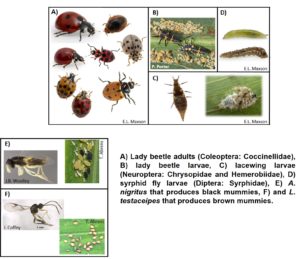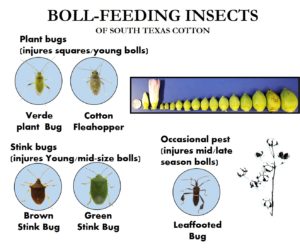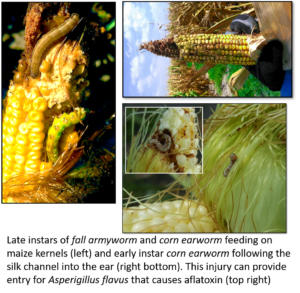Summary
The Field Crops Entomology Program works with industry, Research, Extension, and education partners. Given the large-scale and low-input nature of field crop agroecosystems and ongoing pest invasions affecting U.S. agriculture, goals have been two-fold: developing sustainable and area-wide approaches to managing pests in agroecosystems, and increasing understanding of plant-insect-natural enemy interactions and pest regulation that affect pest outbreak, severity, and regulation. Developing sustainable pest management tools to address invasive and other major pest concerns provide near-term benefits and increase understanding of pest regulation resiliency in managed systems that serve to buffer the impact of pest invasions.
 An areawide pest management project focused on the invasive aphid Melanaphis sorghi, sorghum aphid, using data from Texas and three other states. In the most recent findings of this multi-state ARS- and NIFA-funded project, lowered risk of M. sorghi risk damaging sorghum was found to be primarily due to mortality caused by aphid predators and parasites (Brewer et al. 2022, Frontiers Insect Sci).Risk in the lower Great Plains agroecosystem has now shifted to now mostly resilient to M. sorghi as seen in past aphid invasions (Brewer et al. 2019, Ann. Rev, Entomol., Brewer and Elliott 2023, Curr. Opinion Insect Sci). Where risk persists (Koralewski et al. 2022, J. Econ. Entomol.), resistant sorghum hybrids can be planted to aid the natural enemies and economic thresholds developed can guide targeted insecticide inputs (Gordy et al. 2019, 2021, J. Econ. Entomol.). This research has helped grower decision making by providing regional risk assessment and local pest management tools. Aphid risk has subsided over the last five years with more strategic local use of insecticides and regional use of aphid resistant sorghum use. Savings of about $25 per acre or about $100 million yearly have been seen across South Texas.
An areawide pest management project focused on the invasive aphid Melanaphis sorghi, sorghum aphid, using data from Texas and three other states. In the most recent findings of this multi-state ARS- and NIFA-funded project, lowered risk of M. sorghi risk damaging sorghum was found to be primarily due to mortality caused by aphid predators and parasites (Brewer et al. 2022, Frontiers Insect Sci).Risk in the lower Great Plains agroecosystem has now shifted to now mostly resilient to M. sorghi as seen in past aphid invasions (Brewer et al. 2019, Ann. Rev, Entomol., Brewer and Elliott 2023, Curr. Opinion Insect Sci). Where risk persists (Koralewski et al. 2022, J. Econ. Entomol.), resistant sorghum hybrids can be planted to aid the natural enemies and economic thresholds developed can guide targeted insecticide inputs (Gordy et al. 2019, 2021, J. Econ. Entomol.). This research has helped grower decision making by providing regional risk assessment and local pest management tools. Aphid risk has subsided over the last five years with more strategic local use of insecticides and regional use of aphid resistant sorghum use. Savings of about $25 per acre or about $100 million yearly have been seen across South Texas.
 Our cotton work on boll-feeding sucking bugs has yielded IPM decision-making tools that have reduced uncertainty in insecticide use for boll protection for sucking bugs and the rot disease they vector. This work was motivated by the practical need to improve the use of insecticides and was coupled with IPM innovation in decision-making by considering thresholds with the option to combine insect density and plant injury evaluations. We also examined the sensitivity of cotton response to cotton fleahopper feeding under water-stressed and non-stressed conditions. In the near-term, growers will be able to improve pest detection in their fields and use insecticides to control them using verified thresholds based partly on this work.
Our cotton work on boll-feeding sucking bugs has yielded IPM decision-making tools that have reduced uncertainty in insecticide use for boll protection for sucking bugs and the rot disease they vector. This work was motivated by the practical need to improve the use of insecticides and was coupled with IPM innovation in decision-making by considering thresholds with the option to combine insect density and plant injury evaluations. We also examined the sensitivity of cotton response to cotton fleahopper feeding under water-stressed and non-stressed conditions. In the near-term, growers will be able to improve pest detection in their fields and use insecticides to control them using verified thresholds based partly on this work.
Research on sugarcane aphid on sorghum and cotton insects includes developing pest risk assessment tools using remote sensing for insect-derived stress detection and GIS approaches for mapping the temporal and spatial progression of pest infestations. Advances in insect pest monitoring In: Advances in monitoring…, Burleigh Dodds). Documented through on-farm research and demonstration, the percent of monitoring sites above pest threshold have been significantly lower with GIS-facilitated pest monitoring that detected within-field zones of high infestations, resulting in a two-fold acreage reduction in acreage targeted for insecticide use. Results have been recently synthesized in several invited book chapters, with co-authors who are graduates of Dr. Brewer’s program (Brewer, Elkins 2023, Recent invasions of insect pests, In: Advances in understanding insect pests…, Burleigh Dodds; Brewer, Esquivel, Gordy 2023.
 Work on corn ear-feeding Lepidoptera has demonstrated that pest risk assessment should combine yield quantity (weight) and quality (disease) loss potential. Research is revealing that integrated tactics of insect, disease, and drought stress relief decrease risk to the insects and the mycotoxin-causing organisms they introduce into the ear.
Work on corn ear-feeding Lepidoptera has demonstrated that pest risk assessment should combine yield quantity (weight) and quality (disease) loss potential. Research is revealing that integrated tactics of insect, disease, and drought stress relief decrease risk to the insects and the mycotoxin-causing organisms they introduce into the ear.
Dr. Michael J. Brewer
Publications
Listing is in reverse chronological order. + indicates student or post-doc. Short titles provided. DOI indicates open access via web, all available as single copies for personal use by emailing M. Brewer
Research.
- Brewer, M.J., I.L. Esquivel, and J.W. Gordy. 2023. Advances in insect pest monitoring using pest population growth and geospatial data for pest risk assessment. 28 pp, Chapter 7 IN: M Fountain and T Pope (eds). Advances in monitoring of native and invasive insect pests of crops. Burleigh Dodds Science Pub., Cambridge, UK.
- Brewer, M.J., and B.H. Elkins. 2023, Recent invasions of insect pests of wheat and sorghum. 31 pp, Chapter 13 In: SO Eigenbrode and A. Rashed (eds). Advances in understanding insect pests affecting wheat and other cereals. Burleigh Dodds Science Pub., Cambridge, UK.
- Brewer, M.J., and N.C, Elliott. 2023. Recent advances in agroecological research for increasing scope of areawide pest management of arthropods in cropping systems. Current Opinion in Insect Science 56: 101019. Doi: 10.1016/j.cois.2023.101019
- Brewer, M.J., N.C. Elliott, E.L. Esquivel+, et al. 2022. Natural enemies, mediated by landscape and weather conditions, shape response of the sorghum agroecosystem of North America to the invasive aphid Melanaphis sorghi. Frontiers in Insect Science. 2, doi: 10.3389/finsc.2022.830997
- Koralewski, T.E., H.-H. Wang, W.E. Grant, M.J. Brewer, and N.C. Elliott. 2022. Evaluation of areawide forecasts of wind-borne crop pests: sugarcane aphid (Hemiptera: Aphididae) infestations of sorghum in the Great Plains of North America. J. Econ. Entomol 115: 1-6. doi: 10.1093/jee/toac035.
- Gordy, J.W.+, N.J. Seiter, D.L. Kerns, F.P.F. Reay-Jones, R.D. Bowling, M.O. Way, and M.J. Brewer. 2021. Field assessment of aphid doubling time and yield of sorghum susceptible and partially resistant to sugarcane aphid (Hemiptera: Aphididae), J. Econ. Entomol., 2021; toab135, doi: 10.1093/jee/toab135.
- Esquivel, I.L.+, M.J. Brewer, and R.N. Coulson. 2020. A native bee, Melissodes tepaneca, benefits cotton production. Insects. 11, 487; doi:10.3390/insects11080487.
- Esquivel, I.L.+, M.J. Brewer, and R.N. Coulson. 2020. Field edge and field-to-field influences on two cotton herbivores: cotton fleahopper and verde plant bug. J. Econ. Entomol. 113: in press.
- Pruter, L.S.+, M. Weaver, and M.J. Brewer. 2020. Overview of risk factors and strategies for management of insect-derived ear injury and aflatoxin accumulation for maize grown in subtropical areas of North America. J. Integ. Pest Manage. 11:8, doi: 10.1093/jipm/pmaa005.
- Brewer, M. J., L. Deleon+, and I. L. Esquivel.+. 2020. Geographic information system (GIS)-based mapping and spatial analyses applied to risk assessment and resource allocation for boll weevil. Ann. Entomol. Soc. Amer. 113: 71-78.
- Pruter, L.S.+, M.J. Brewer, et al.. 2019. Association of insect-derived ear injury with yield and aflatoxin of maize hybrids varying in Bt transgenes. Environ. Entomol. 48: 1401-1411.
- Maxson, E.L.+, M.J. Brewer, et al. 2019. Species composition and abundance of the natural enemies of sugarcane aphid. Proc. Wash. Entomol. Soc. 121:657-680.
- Glover, J.P.+, G.A. Sword, and M.J. Brewer. 2019. Photoperiod-specific within-plant distribution of the green stink bug on cotton. Environ. Entomol. 48: 1234-1240.
- Wang, H.-H., W.E. Grant, et al. 2019. Integrated modelling of the life cycle and aeroecology of wind-borne pests in temporally variable spatially heterogeneous environment. Ecol. Modelling 399: 23-38.
- Gordy, J.W. +, M.J. Brewer, et al.. 2019. Development of economic thresholds for sugarcane aphid in susceptible grain sorghum hybrids. J. Econ. Entomol. 112: 1251-1259.
- Glover, J.P. +, M.J. Brewer, et al.. 2019. Plant response and economic injury levels for a boll feeding sucking bug complex on cotton. J. Econ. Entomol. 112:1227-1236.
- Brewer, M.J., and J.P. Glover +. 2019. Boll injury caused by leaffooted bug in late-season cotton.Crop Protect. 119: 214-218.
- Brewer, M.J., F.B. Peairs, and N.C. Elliott. 2019. Invasive cereal aphids of North America: ecology and pest management. Ann. Rev. Entomol. 64: 73-93.
- Stanton, C.+, M. J. Starek, et al. 2017. Unmanned aircraft system-derived crop height and normalized difference vegetation index metrics for sorghum yield and aphid stress assessment. J. Applied Remote Sensing 11: 026035, doi:10.1117/1.JRS.11.026035.
- Weaver, M.A., H.K. Abbas, et al. 2017. Integration of biological control and transgenic insect protection for mitigation of aflatoxin in corn. Crop Protect. 98:108-115.
- Deleon, L.+, M. J. Brewer, et l.. 2017. Use of a geographic information system to produce pest monitoring maps. Crop Protect. 101: 50-57.
- Bowling, R., M.J. Brewer, et al. 2016. Sugarcane aphid (Homoptera: Aphididae): a new pest on sorghum. J. Integr. Pest Manage. 7: 12; doi.org/10.1093/jipm/pmw011.
- Outreach.
- Faris, A.M. +, and M. J. Brewer. 2019. Natural enemies of the sugarcane aphid on sorghum in south Texas, 6 pp. ENTO-091. Texas A&M AgriLife Ext., College Station.
- Bowling, R., J. Thomas+, and M. Brewer. 2017. Common aphid identification in Texas grains, 2 pp. ENTO-070. Texas A&M AgriLife Extension, College Station.
- Bowling, R, M. Brewer, et al. 2016. Scouting sugarcane aphids in the south, central, and west Texas, 2 pp. ENTO-043/ENTO-043S (Spanish), Texas A&M AgriLife Extension, College Station.
- Knutson, A., R. Bowling, et al. 2016. The sugarcane aphid: management guidelines for grain and forage sorghum in Texas, 6 pp. ENTO-035. Texas A&M AgriLife Extension, College Station.


